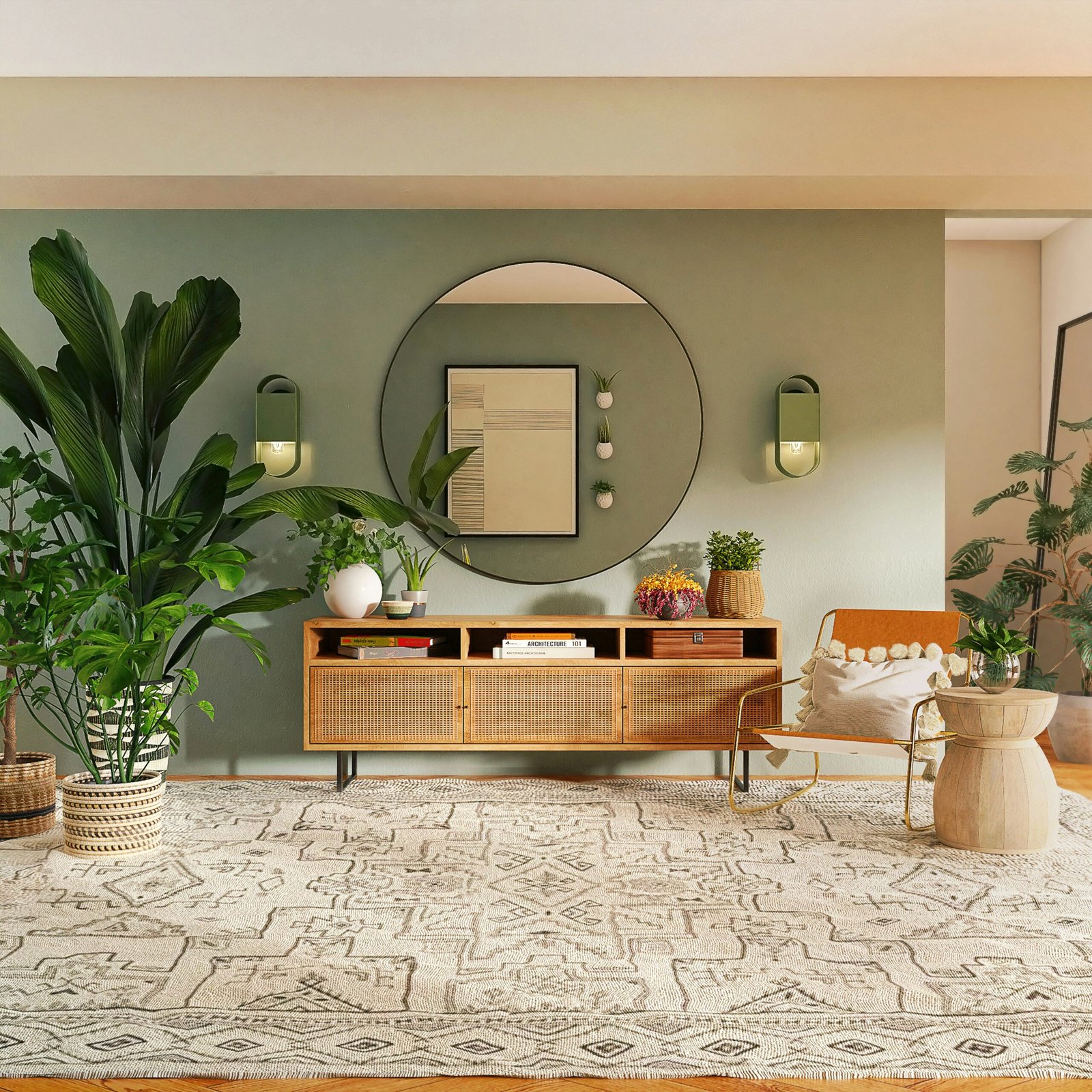Understanding the Importance of Rugs in Living Spaces
Rugs play a pivotal role in enhancing both the aesthetic and functional aspects of a living room. They are not merely decorative elements; instead, they serve to define spaces, add warmth, and contribute meaningfully to the overall decor theme. Selecting the right rug can significantly influence the ambiance and comfort of a living area, making it an essential component in interior design.
One of the primary functions of a rug is space definition. In open-plan living environments, a well-placed rug can create a visual boundary, distinguishing the living area from dining or kitchen spaces. This delineation fosters a sense of organization while promoting a cohesive flow throughout the home. By utilizing different shapes, sizes, and colors, rugs can help segment an area, thereby enhancing the overall functionality of the space.
Additionally, rugs add a layer of warmth and comfort that can be especially appealing in a living room setting. They soften hard surfaces such as wood, tile, or concrete, making them more inviting. The texture of a rug can invite people to gather and spend time in a space, encouraging relaxation and interaction. Furthermore, a rug can help in noise reduction, muffling sounds and creating a quieter environment, thereby enhancing the overall comfort level within the room.
The right rug also acts as a connecting element, uniting various decor styles and colors present within the living room. It can tie together furniture pieces, creating a harmonious and visually appealing layout. By carefully considering the design, texture, and color of the rug, homeowners can ensure that it enhances the existing decor while also reflecting their personal taste.
Ultimately, understanding the importance of rugs in living spaces underscores the impact that the right choice can have on both functionality and aesthetics. Making a thoughtful selection can elevate the living room into a more comfortable and beautifully coordinated space.
Factors to Consider When Selecting a Rug
Choosing the perfect rug for your living room involves several important factors that can significantly influence both the aesthetic and functional aspects of the space. The size of the rug is paramount; it should harmonize with the layout of your furniture. Ideally, the rug should be large enough to fit under the front legs of a sofa and accompanying chairs, creating a cohesive look and defining the seating area. Measuring your space before making a purchase can prevent the common mistake of choosing a rug that is either too small or excessively large.
Material is another critical consideration. Rugs are available in a multitude of fabrics, including wool, synthetic fibers, and natural fibers such as jute or cotton. Each material offers unique durability and maintenance aspects, which can affect their suitability based on your lifestyle. For instance, households with pets or small children may benefit from more durable, stain-resistant options, while those seeking luxury may prefer the softness of a wool rug.
Color and pattern also play a vital role in your selection process. A rug can serve as a statement piece or a subtle accent within your living room. Assessing the existing color palette and decor style is essential to finding a rug that complements your space. If your room has bold colors or intricate patterns, a simpler rug may create a pleasant balance. Conversely, if the environment is relatively neutral, a vibrant or patterned rug could inject life and personality into the setting.
Lastly, your lifestyle needs should influence your rug choice. Consider the amount of foot traffic in the area where the rug will be placed, as some materials are better suited for high-traffic environments than others. Understanding how you use the living room will also guide your decision-making process, ensuring that your chosen rug enhances both the style and function of the space.
Exploring Different Rug Materials
When selecting the perfect rug for your living room, understanding the various materials available can greatly influence your decision. Rugs come in a multitude of materials, each offering unique characteristics that cater to different aesthetic preferences and functional needs. The primary categories of rug materials include natural fibers, synthetics, and blends, each with its own set of advantages.
Natural fibers, such as jute and wool, are popular choices for their durability and sustainable qualities. Jute rugs, such as the Nuloom Rigo Jute Rug, not only provide a textured, earthy vibe to your space but are also incredibly durable. Jute is a biodegradable material, making it an environmentally friendly option. However, maintenance can be somewhat demanding, as jute rugs may require occasional professional cleaning to retain their appearance.
Wool, another natural fiber, is renowned for its softness and resilience. It acts as an excellent insulator, providing comfort underfoot, while also being stain-resistant and easy to clean. Wool rugs can add warmth and elegance to a living room, making them a favored choice for homeowners looking for both comfort and style.
On the other hand, synthetic materials like polypropylene and nylon are gaining popularity due to their affordability and vast design options. These rugs are often more stain-resistant and easier to maintain than their natural counterparts. Synthetics can mimic the appearance of wool or jute, providing a budget-friendly alternative without sacrificing aesthetics.
Finally, blended materials combine fibers to optimize durability and comfort. For instance, blending wool and synthetic fibers can create a rug that is soft yet highly resistant to wear and tear. This versatility can be particularly beneficial in high-traffic areas like the living room, where durability is paramount. Overall, the selection of the material should align with your lifestyle and preferences, ensuring both beauty and functionality in your living space.
The Right Rug Size for Your Living Room
Choosing the perfect rug size for your living room starts with accurate measurements of your space. To determine the appropriate dimensions, first, you should measure the length and width of your living area. This will help you visualize how a rug can complement your existing furniture and layout. A guideline often used is to have at least 18 to 24 inches of bare floor visible around the edges of the rug, which creates a frame that can enhance your room’s proportions.
Moreover, rug placement is crucial in defining the aesthetic and functionality of your living space. If you have a sofa or seating arrangement, consider placing the front legs of your furniture on the rug. This setup creates an inviting atmosphere and visually connects different areas of the room. Alternatively, for a more anchor-like effect, you could position larger rugs under all the furniture, allowing it to encompass the entire seating arrangement. This approach is especially beneficial in open-concept living spaces.
For smaller rooms, a round rug can soften the look and make the area feel more spacious. In contrast, if your living room features a large coffee table, a rectangular rug that extends beyond the edges of the table can create unity. Remember to leave a few inches between the rug and walls or large furniture pieces to maintain balance and flow within the space.
Utilizing painter’s tape can be an effective method to visualize rug sizes and placements before making a purchase. By outlining different dimensions on your floor, you can gauge how each option will impact your living room’s overall look and feel. Ultimately, selecting the right rug size plays a critical role in enhancing the ambiance, comfort, and style of your living area.
Choosing Colors and Patterns That Complement Your Decor
When selecting a rug for your living room, the importance of color and pattern cannot be overstated. The right hues and designs can enhance the overall aesthetic of your space, creating a harmonious atmosphere that reflects your personal style. Start by considering the existing decor in your living room, including wall colors, furniture styles, and accessory choices. A well-chosen rug can either match these elements for a cohesive look or provide a striking contrast that adds visual interest.
For modern and minimalist spaces, consider selecting rugs with neutral tones or subtle patterns. Shades of gray, beige, and white can seamlessly blend with your decor, allowing the furniture to take center stage. Additionally, geometric patterns or abstract designs can introduce a contemporary flair without overwhelming the room. When opting for brighter colors, ensure that the rug complements rather than clashes with your existing palette.
On the other hand, traditional decor often benefits from rugs that feature rich colors and intricate patterns. Deep reds, greens, and browns can evoke a sense of warmth and elegance. Persian or Oriental rugs, with their elaborate designs, can serve as a focal point and add a layer of sophistication to your living space. If you wish to create a more eclectic feel, explore bohemian styles, which often incorporate a mix of colors and patterns. Layering rugs with varying textures can provide depth and personality to the room.
Moreover, consider the size of the rug in relation to your furniture arrangement. A larger rug can anchor the space, while smaller rugs can create defined areas within the room. Ultimately, choosing colors and patterns that complement your decor is about balancing personal preference with the overall theme of your living room, ensuring that the final selection enhances the ambiance while reflecting your unique taste.
Understanding Rug Pads: Why You Need One
When selecting a rug for your living room, it is essential to consider the use of a rug pad. Rug pads serve multiple purposes that enhance both the aesthetic and functional aspects of your flooring. One of the primary benefits of using a rug pad is that it prevents slipping. A rug can easily slide on hard surfaces, posing a safety hazard for family members and guests. A high-quality rug pad establishes a stable base, helping to keep the rug in place and reducing the risk of accidents.
In addition to providing stability, rug pads offer a level of cushioning that enhances comfort. Standing or walking on a rug without a pad can feel hard underfoot, while a good rug pad adds a layer of soft padding, making your living space feel more inviting. This extra cushioning can also contribute to reducing noise, creating a quieter home environment, which is particularly beneficial in high-traffic areas such as the living room.
Moreover, using a rug pad protects your flooring. Whether you have hardwood, tile, or laminate, a rug can cause wear and tear over time, particularly if it shifts frequently. A rug pad acts as a barrier that reduces friction between the rug and the floor, thus safeguarding your surfaces from scratches and damage. The Amazon Basics Rug Pad is an excellent example of an affordable yet effective choice that can cater to various types of rugs and flooring surfaces.
When selecting a rug pad, it is crucial to match its size and type with your chosen rug. Look for options that provide adequate thickness for cushioning and ensure the pad is slightly smaller than the rug to avoid peeking edges. By investing in a quality rug pad, you can amplify the benefits of your living room rug, making it a more functional and visually appealing element in your home.
Maintenance and Care for Your Living Room Rug
Maintaining the aesthetic appeal and longevity of your living room rug requires regular care and attention. Whether your rug is made of natural fibers like wool or synthetic materials like polypropylene, each type demands specific maintenance techniques. Instituting a cleaning schedule will significantly enhance your rug’s lifespan and appearance.
Begin with routine vacuuming to eliminate dust and debris that can become embedded in the fibers. For rugs placed in high-traffic areas, it is advisable to vacuum at least once a week. Be sure to use a vacuum cleaner with a suction-only setting for delicate rugs to avoid damage to their texture. In addition to vacuuming, you should consider rotating your rug periodically. This helps to distribute wear evenly, particularly in spaces where furniture may cause uneven flattening or fading.
Stain removal can be particularly challenging, especially in homes with pets or children. For immediate response to spills, blot the area with a clean, dry cloth to absorb excess liquid. Avoid rubbing, as this can spread the stain. Depending on the type of stain, a mixture of mild soap and water can be effective. Always test any cleaning solution on a small, inconspicuous area of the rug before applying it more broadly. For tougher stains, enzymatic cleaners work well for organic messes, while specialized products exist for different materials.
Additionally, preventing damage through protective placement is advisable. Use rugs in areas with less exposure to direct sunlight, as UV rays can cause fading over time. Consider using a rug pad underneath to provide cushioning and prevent slipping, which is especially beneficial in homes with children or elderly individuals.
By adhering to these maintenance and care guidelines, your living room rug will not only look great but will also remain a cherished component of your home for many years to come.
Stylish Rug Ideas to Inspire Your Living Room Design
Choosing the right rug is essential for enhancing the overall aesthetic of your living room. Rugs serve not only as soft furnishings but as central pieces that can anchor your design. One popular option is the Safavieh runner rug, characterized by its elegant patterns and versatile sizes. It can fit seamlessly into both narrow spaces and wider openings, making it ideal for various living room layouts. When paired with a neutral sofa, the intricate designs of the Safavieh rug can add depth and interest, creating a focal point that draws attention.
Another stylish consideration is the bohemian rug, which often features vibrant colors and eclectic patterns. This style works exceptionally well in casual or relaxed living spaces, allowing for a laid-back vibe. Combining a bohemian rug with refined wood furniture can create a striking contrast, enhancing the character of both elements. Additionally, layering rugs can be a clever design strategy; for example, placing a smaller, patterned rug on top of a larger, neutral one can help define various areas within an open-plan living room.
For a more contemporary touch, geometric rugs have gained popularity due to their clean lines and modern appeal. When one selects a geometric rug, it can complement minimalist furniture beautifully, creating a balanced and sophisticated look. Furthermore, using monochromatic colors can elevate the space’s elegance while lending a sense of cohesion to the overall décor.
Lastly, don’t shy away from natural fiber rugs, such as jute or sisal, which can introduce texture and warmth into your living room. These rugs often pair well with rustic or farmhouse-style furniture, enhancing the organic feel of the decor. By considering these stylish rug ideas for your living room, you can transform your space into a harmonious blend of comfort and style.
Final Thoughts: Making Your Choice
When selecting the ideal rug for your living room, a balanced approach that combines both practicality and style is essential to ensure your space reflects your personal taste while serving its functional purpose. A well-chosen rug can anchor a room, enhance the ambiance, and even serve as a focal point. To arrive at the best decision, consider summarizing your preferences and evaluating how they align with your overall vision for your living space.
To begin with, reflect on the size of your living room and the existing furniture layout. The size of the rug should complement your furniture arrangement, as it can help unify disparate pieces or define separate areas within an open floor plan. Furthermore, examine the material and texture of the rug. Different fabrics offer varying benefits; for instance, a wool rug provides durability and warmth, while a cotton rug may be easier to clean and maintain. Your choice should factor in foot traffic, family needs, and the cleaning regimen you are willing to adhere to.
Next, consider the color palette and pattern of the rug. It is crucial to select a design that harmonizes with your living room décor. Bold designs can make a statement, while muted tones can create a serene backdrop. Striking the right balance between style and function is vital, as a rug that complements your decor but fails to serve its intended purpose can negatively impact the room’s atmosphere.
Ultimately, once you summarize your preferences, reflect on how they fit within the broader context of your living room. By thoughtfully considering each element, you can confidently choose a rug that enhances the ambiance and aesthetics of your space, creating a harmonious environment for relaxation and gathering.


